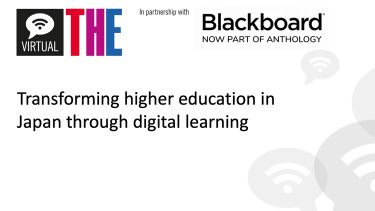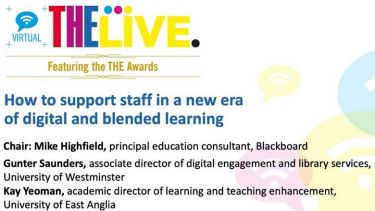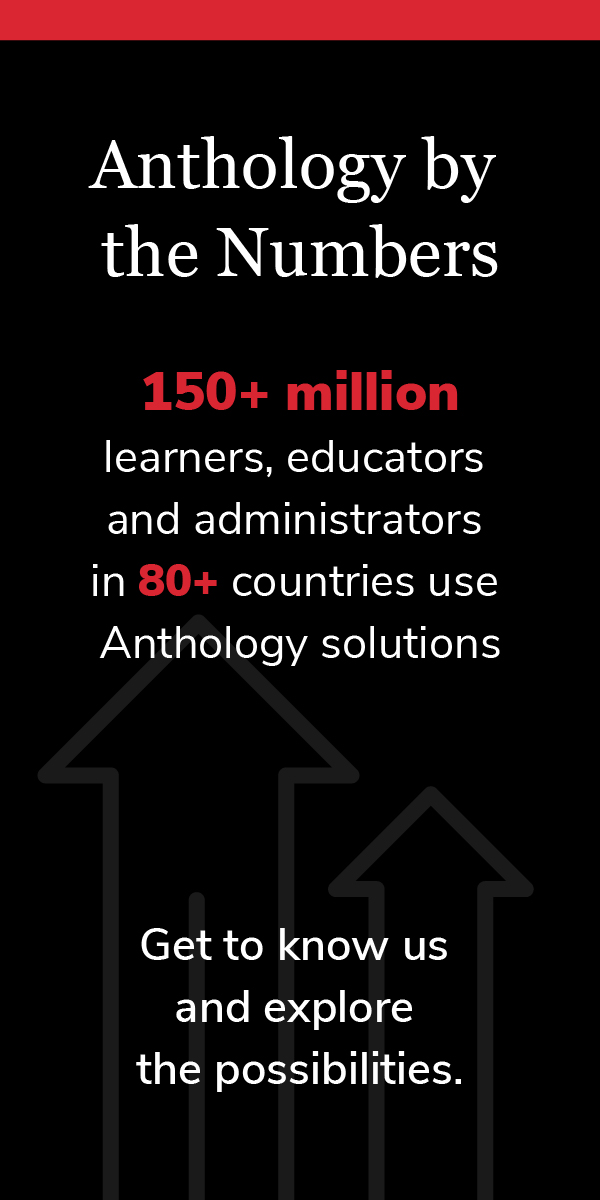
The pandemic cultivated greater internal communication and allowed institutions to better respond to student needs
“There’s no returning to the old ways,” said Times Higher Education’s chief knowledge officer, Phil Baty, at a webinar held as part of the Asia Pacific Virtual Leadership Summit. “There is a new normal, and digitally enhanced blended learning will be a major part of the future.”
The webinar, which was hosted in collaboration with Blackboard, investigated the opportunities and challenges posed by the pandemic. Last year, institutions around the world scrambled to introduce remote online teaching when they were forced to shut their doors. While initially an emergency measure, the digital push ushered in a new era of higher education.
“We’re looking to build greater resilience and flexibility into our educational practice,” said Professor Simon Bedford, pro vice-chancellor for learning futures at Western Sydney University in Australia. The pandemic highlighted that there is no one-size-fits-all response when it comes to the needs of different disciplines. While business faculty and students were able to shift relatively seamlessly to online instruction, those in STEM fields struggled. “They had to create new content from scratch,” Bedford said. STEM subjects are also very practical, and educators are still struggling to offer equivalent hands-on aspects of the curriculum to students online.
In the future, students are expected to be in the driving seat and universities will have to tailor their offerings to their needs. Instead of the face-to-face, timetable-tethered model of teaching, future offerings will involve “giving students the choice to learn synchronously, either face to face or online, or asynchronously”, Bedford said.
Students are demanding flexibility, and this will be a major institutional drawcard, particularly for international students. “There’s a sense that the pandemic could really shake-up the international student market,” Baty said.
The ability to attract the world’s best talent is vital to institutions’ research output and reputation, but the pandemic has severely constrained their ability to recruit students. And while border closures and restrictions have physically stopped students from travelling to other countries, rising nationalism has created an unwelcoming environment for many foreign students, which could encourage them to look at universities beyond Europe and North America.
Based on THE surveys, Baty said that although the US and Europe continue to dominate its rankings, a slow geopolitical change is occurring in higher education, “with the flow of talent and the centre of gravity shifting east”. “That presents a really interesting and exciting opportunity [for Asia-Pacific] universities,” he said.
For now, many universities are still coming to terms with how Covid-19 has changed their institutional offering. Feedback from management, staff and students has been essential to the success of their pandemic response, said Professor Cheryl Peralta, vice-rector for academic affairs at the University of Santo Tomas in the Philippines. Feedback systems ranged from surveys to gauge how faculty and students were coping with – and responding to – challenges, to offering courses and mentoring to staff to help them get to grips with new technologies.
A major impediment to the successful shift online, and something experienced by institutions around the world, has been the “digital divide”, which refers to the gap between those who can access digital technologies (such as computer hardware, software and the internet) and those who cannot.
At the University of Santo Tomas, this divide was highlighted by their ongoing surveys, Peralta said, and led to a massive drive to ensure that teachers and learners had access to the resources they needed. The institution also offered courses to teach faculty how to create digital courses that used less bandwidth, Peralta said.
Meanwhile, Western Sydney University created study halls on campus, so students could access quiet spaces with internet access to work in. However, international students who were unable to travel to Australia struggled. This was because many countries, such as China, heavily regulate the internet and restrict access to materials.
Another area of higher education that is experiencing an overhaul is assessment, the panellists agreed. Many institutions are realising that “locking people in a room for three hours” may not be the best way to assess their understanding of a subject, said Bedford. Innovative assessment methods are flourishing as a result of the pandemic, and are addressing many of the concerns that plagued old methods, such as cheating.
“We’ve moved all our assessment online,” said Peralta. Her institution is also working to develop assessments that are integrated across courses. “Therefore, students will just be working on a few assessments, applying principles that they’ve learnt from more than one course,” she said. This type of assessment better mimics the professional world and is something the university will maintain post-pandemic, she said.
As the world struggles under the economic pressures of the pandemic, graduates require skills that respond to the needs of industry. Meanwhile, working or unemployed professionals need to be able to upskill and reskill quickly. “In the new economy, you’re just going to need constant upskilling and reskilling, and real flexibility throughout lifelong learning,” said Baty.
One way to address this need is through microcredentials and short credentials, which are “bite-sized” pieces of learning that teach students a specific skill or subset of knowledge. Such educational offerings have been important in professional development, enabling workers to acquire new skills. But there is a push to “stack” microcredentials and give students the flexibility to design their own degrees. While this could work within institutions, sharing credentials between universities remains an unsolved problem, the panellists said.
That inertia could change if institutions capitalise on the speed and agility with which they responded to the pandemic. All the panellists voiced the hope that this momentum would continue into the future. “We have found a level of agility, innovation and resilience in higher education that's just been phenomenally inspirational and exciting,” Baty said. “It is something we need to continue to let us drive forward.”
Watch the round table on demand here.
Find out more about Blackboard and higher education.






















